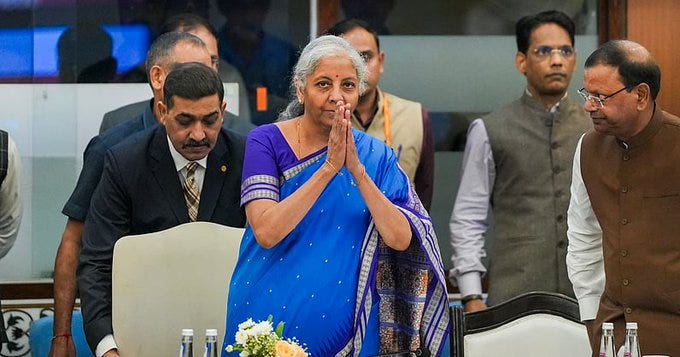Use GST Recast Mood to Cast Reform Net Wider
The mood presents an opportunity to overcome inertia - clear the cobwebs, park the value of PSE holdings into a sovereign fund to support exports and research. The urgency cannot be overstated.
The good news is that simplification of tax slabs has arrived. GST is still work in progress — cess, inverted duties, classification confusions persist. The hope that rate cuts will propel growth belongs to the ‘only time will tell’ category. The economy is shackled by systemic sloth, archaic laws and regulatory cholesterol. The mood presents an opportunity to overcome inertia — clear the cobwebs, park the value of PSE holdings into a sovereign fund to support exports and research. The urgency to enable the India Story cannot be overstated.
Shankkar Aiyar | The Third Eye | The New Indian Express | 07 Sep 2025
AI Podcast : Go Big, Spur Reforms, Trump Tariff Tactics
The good news is that the much-expected simplification of the goods and services tax regime has arrived. You could argue that the urge was driven by political considerations. The trail of alterations since 2017 often carries the scent of electoral economics, and one does remember the khakra tax saga.
It could be also argued that the changes are much-needed measures propelled by the challenge posed by slowing demand amid Trumpian tariff tactics. Of course, the government says the GST reforms are neither about Bihar nor Trump, but the result of 18 months of meetings. That the Centre and states must take 18 months to do ‘good’ is a testament in its own class!
Be that as it may, the hope is that the GST rate cuts will trigger demand and propel growth. The thesis belongs to the ‘only time will tell’ category. The tax reliefs of Budget 2025 are yet to reveal the torque on consumption. As forecasters shift around the decimals of GDP growth, questions hang in the air. Will the cuts boost consumption? The loss of revenue to the government, estimated at Rs 48,000 crore — effectively, money moved from the public to the private sector — is expected to stimulate an economy of Rs 330 lakh crore.
Oftentimes, political intent is waylaid by the hurrahs emanating from the surround-sound amphitheatre. Hopefully, the cliché of missing the woods won’t play out. The GST recast presents an opportunity to leverage the mood and push for deeper reforms. The challenge of 50 percent tariffs on India’s exports to the US is aggravated by the perennially pending structural reforms highlighted in this column earlier.
The economic cost imposed by politics makes Indian exports less competitive vis-à-vis Vietnam, Sri Lanka, or Bangladesh. It is estimated that $48–60 billion of Indian exports to the US are under tariffs. The sectors affected are mass employers.
The pain could traverse India’s export geography from Tiruppur to Noida to Surat. Between them, the gem & jewellery and textile sectors employ over 50 million people. The circumstance necessitates the relief promised by the government and calls for resource mobilisation.
The headroom in the government’s balance sheet is limited — the commitment to bring fiscal deficit down to 4.4 percent and the recent upgrade of ratings by S&P will inform the quantum of funds made available. This brings the spotlight on the old chestnuts: asset monetisation and disinvestments. The Niti Aayog identified projects worth Rs 6 lakh crore for monetisation. The 2025 Budget unveiled a new asset monetisation target of Rs 10 lakh crore. The government must disclose the amount realised in the first programme, debate its use, and set a deadline for the new target.
The biggest opportunity to raise moolah is in unlocking the value of government holdings in public sector enterprises. Three decades after liberalisation, the government of India continues to be one of the largest business houses! This column had, precisely for such contingencies and funding development, proposed that the government’s holdings be parked in a sovereign fund called Amrit Kaal Fund, to be leveraged to raise resources.
To paraphrase Victor Hugo, it is an idea whose time has come. Consider the following. The total market value of listed public sector enterprises is Rs 34.33 lakh crore and that of all listed public sector banks is over Rs 15.9 lakh crore. The government’s holdings in undertakings such as LIC, GIC, RVNL, IRFC, Mazgaon Docks and many banks are in excess of 80 percent. If the government were to park its holdings in excess of 51 percent into a fund and offer it in the market as part of a Bharat Fund, it would address the concern on valuations and afford a substantial sum over a period of time.
Money makes the mare go round, but is only a means to execute intent. India’s economy is shackled by systemic sloth, archaic laws and regulatory cholesterol. The Economic Survey 2024 presented a framework for growth, highlighting the need for deregulation. In September 2025, the idea is still being debated in committees.
Investors queue up at state capitals and in Delhi for permits; businesses are haunted by a plethora of compliances. The GST system hailed this week is still a work in progress shackled by cess, inverted duties, classifications and the threat of imprisonment. Of the over 1,843 laws governing businesses, more than 800 carry imprisonment clauses. The promise to decriminalise some of the provisions, as of now, is still a bill.
The Trump tariff threat calls for expansion to newer markets. Samsung, Sony, Toyota and Xiaomi have engineered leverage for their nations with global brands. The unstated truth about Indian corporates is that they have struggled to build scale and distinctive quality. One reason, among many ranging from systemic rigidities to poor credit markets, is lack of investment in R&D.
This is critical for a global edge, and yet, Rs 20,000 crore budgeted for private sector R&D is yet to be disbursed. The ‘one district, one product’ idea was designed to enable diversification in output and exports, but is flailing. The disruptions caused by technology are upending livelihoods. India needs a public-private skilling-reskilling revolution; meanwhile, Rs 70,000 crore for labour welfare is lying idle.
The world order is unravelling rapidly. India’s political class needs to look around and stop whistling past graveyards. Economic distress is at the core of strife, schism, and upheaval in democracies. Impunity of inaction does not afford immunity from consequences.
Shankkar Aiyar, political economy analyst, is author of ‘Accidental India’, ‘Aadhaar: A Biometric History of India’s 12-Digit Revolution’ and ‘The Gated Republic –India’s Public Policy Failures and Private Solutions’.
You can email him at shankkar@shankkaraiyar.com and follow him on X / Twitter @ShankkarAiyar. This column was first published here. His previous columns can be found here.



